|
|
Het Groote Tafereel der Dwaasheid The Great Mirror of Folly'. |
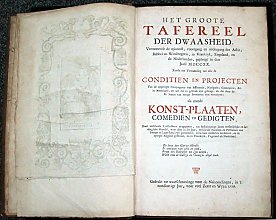
|
'Het
Groote Tafereel der Dwaasheid' [The Great Mirror of Folly] was published
in Amsterdam, 1720. Full title 'Het Groote Tafereel der Dwaasheid, vertoonende de opkomst, voortgang en ondergang
der Actie, Bubbel, en Windnegotie, in Vrankryk, Engeland, en de Nederlanden, gepleegt in den Jaare MDCCXX.
[The Great Theatre of Folly, representing the origin, progress and downfall of the Share, Bubble, and
Wind trade in France, England and the Netherlands, perpetuated in the Year MDCCXX.]
No indication is given of its publisher(s), printer(s), editor(s) or compiler(s).
The book is a curious collection of
emblematic plates and caricatures that makes a butt of among others the
exaggerated share prices of the 'Verenigde Oostindische Compagnie' [United
East India Company] whereas the itinerant lanternist was identified with a fleeting fad and ridiculous
practices. The selection of the plates was done in accordance with client's
wishes, so no two copies of the book are exactly alike. An existing index
gives 56 different engravers for the plates. |
One of the most interesting engravings is the 'Actieuse NACHT-WIND-Zanger met
zijn Tover Slons', which is 18th century Dutch for 'Night-wind singer with his Magic Lantern in
action'.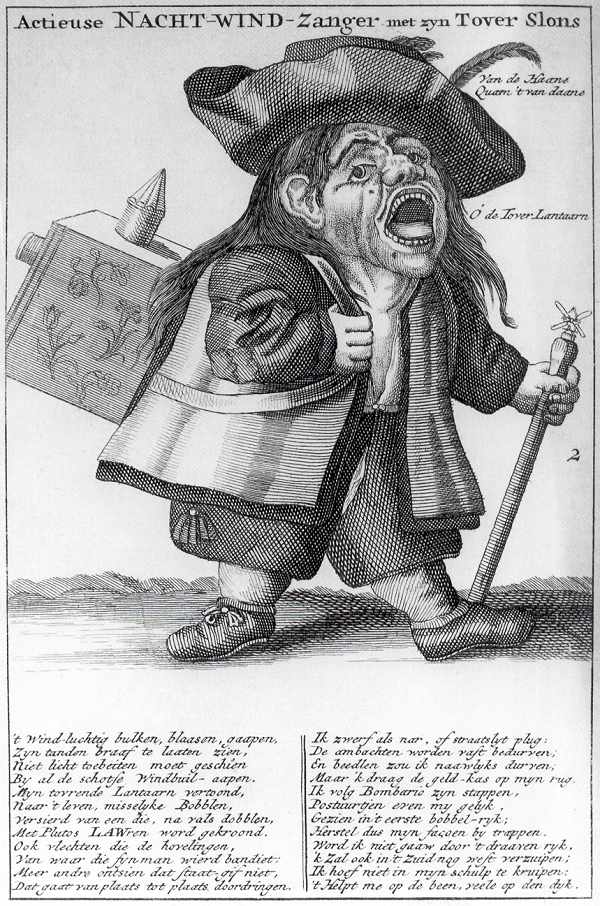
The image shows a small windmill at the top of his cane. This represents the Dutch expression 'met molentjes lopen' (to be a little bit mad). |
|||
|
’t Wind-luchtig bulken, blaasen, gaapen, Zijn tanden braaf te laaten zien, Niet licht toebeiten, moet geschîen Bij al de schotse Windbuil-aapen. Mijn tovrende Lantaarn vertoond, Naar ’t leven, misselijke Bobblen, Versierd van een die, na vals dobblen, Met Plutos LAWren word gekroond. Ook vlechten die de hovelingen, Van waar die fijn man wierd bandiet: Meer andre ontsien dat Staat gif niet, Dat gaat van plaats tot plaats doordringen. |
Ik zwerf als nar, of straatslijt plug: De ambachten worden vast bedurven; En beedlen zou ik naawlijks durven; Maar ‘k draag de geld-kas op mijn rug. Ik volg Bombario zijn stappen, Postuurtjen even mij gelijk, Gezien in’t eerste bobbel-rijk; Herstel dus mijn façoen bij trappen. Word ik niet gaaw door’t draaven rijk, ‘k Zal ook in’t Zuid nog west verzuipen; Ik hoef niet in mijn schulp te kruipen: ’t Helpt me op de been, veele op den dijk. |
||
|
The Dutch version
of this page gives the 'translation' of a number of 18th century Dutch words
into modern Dutch. Interesting is the use of the word 'SLONS', which in
present day Dutch stands for 'frump', or 'dirty woman'. One of the meanings
in old Dutch however was 'lantern' (compare with the English 'sconce', a
candle holder that is attached to a wall with an ornamental bracket). So 'Tover
Slons' means 'Magic Lantern'. '... volg Bombario zijn stappen'. 'Following Bombario's tracks'. In the criticizing writings from about 1720 the name of Bombario often appears as the personification of the stock-jobbery. |
|||
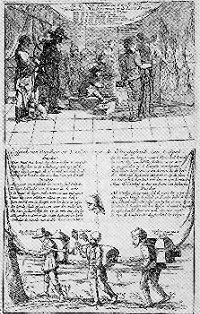
|
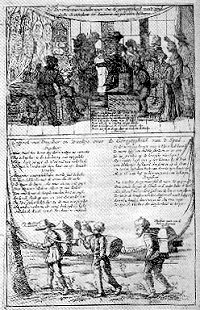
|
Two other pages from 'Het
Groote Tafereel der Dwaasheid' depicting the magic lantern. |
|
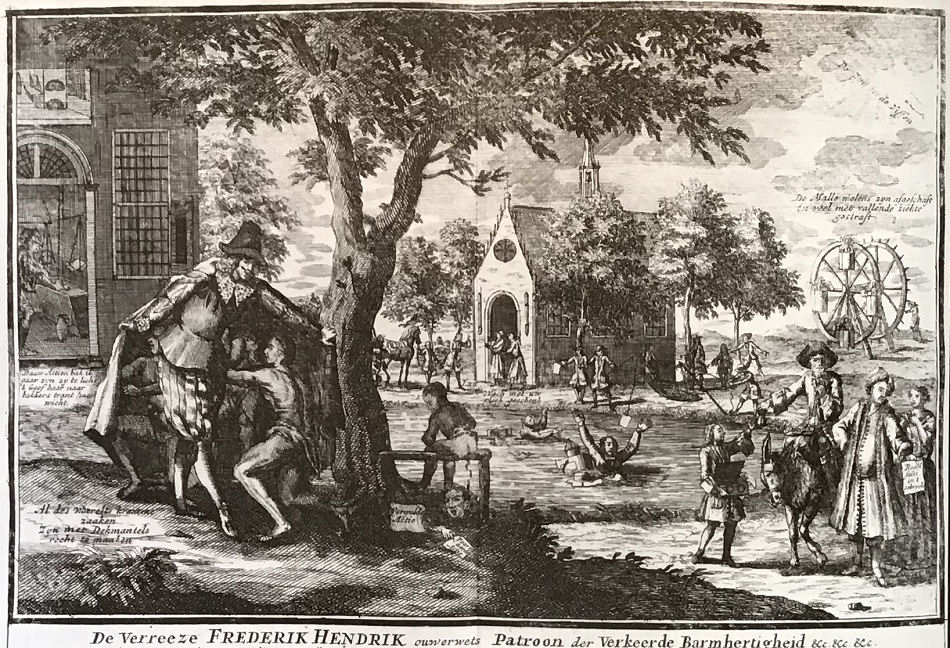 |
|
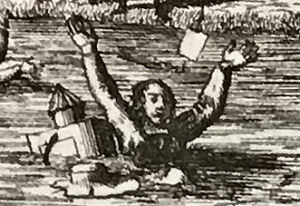 |
De Verreeze Frederik Hendrik, ouwerwets
Patroon der Verkeerde Barmhartigheid. The Verreeze Frederik Hendrik, Old Fashioned Pattern of Wrong Mercy. The lanternist falls in the water together with his magic lantern. Sellers of shares and magic lantern showmen were seen as traders in air, in illusions. |
 |
|
 |
The engraving above comes from an
important account detailing one of the most notorious financial collapses in
history, known as the Mississippi Bubble Incident. It includes 18
compartments marked A to S, designed to be separated and used as playing
cards. Each compartment features a distinct character engaged in particular
activities or circus acts; for example, in compartment B, a man points an
arrow at the sun while trying to capture running rabbits and mice.
Additionally, in compartment G, a strong man grips a bench between his
teeth, while compartment M depicts a man balancing on a chair on his foot
while another dives into a burning barrel. Notably, compartment S depicts a
man riding a cannon, bound at the wrists, while the devil, depicted as
Professor Bombarismi, holds a wheel and lights the cannon's fuse. In compartment E we see a man carrying a magic lantern on his back and a normal lantern in his hand. Caption: Scarmoes vlamd met zijn dieve-en tover-nacht-lantaren, Op Colombins boutiekje, om wind-breuk-zalf te gaaren. |
| The Mississippi Bubble was initiated by John Law, a Scottish financier who established the Banque Générale (central bank) in France and later took control of Louisiana by founding the Compagnie de la Louisiana d'Ouest in 1717. Law designed an elaborate plan to exploit the region's abundant resources, attracting numerous investments not only in France but throughout Europe. This fervor led to the emergence of numerous foreign companies, including the English South Sea Company and several smaller entities in the Dutch Republic, causing stock prices to skyrocket amid a speculative frenzy. However, the bubble burst in 1720, triggering panic selling, a collapse in stock prices, and ultimately the company's bankruptcy. The repercussions extended beyond the financial ruin of individual investors, shaking confidence in similar businesses and leaving thousands of people across Europe financially devastated. | |
| Printed as a warning for Posterity, in this fateful year for many Fools and Wise men, Amsterdam 1720. (title page) | |
| |
©1997-2024 'de Luikerwaal' All rights reserved. Last update: 03-05-2024. |